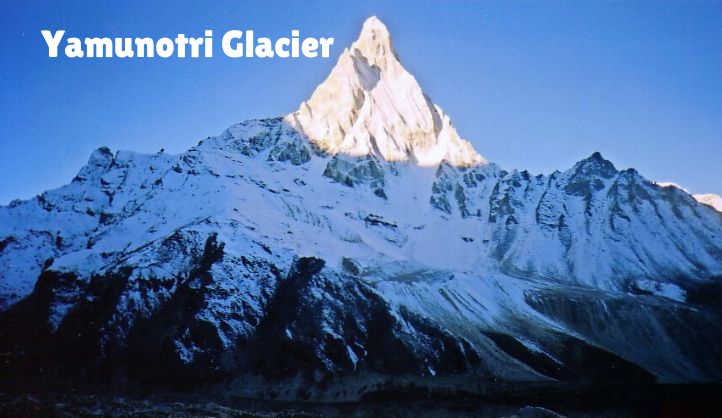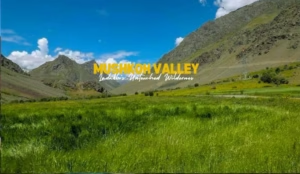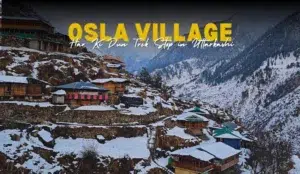Nestled in the majestic Garhwal Himalayas, the Yamunotri Glacier is a breathtaking natural wonder that serves as the primary source of the Yamuna River, one of the most sacred rivers in India. This glacier, located at an altitude of approximately 6,387 meters above sea level, is surrounded by towering snow-capped peaks, deep gorges, and verdant forests, making it a place of immense natural beauty and spiritual significance. The journey to the Yamunotri Glacier is a pilgrimage for many, offering not only an opportunity to connect with nature but also a chance to experience the profound spirituality that permeates this remote region.
Geographical Overview of Yamunotri Glacier
The Yamunotri Glacier is situated in the western part of the Garhwal Himalayas in the Uttarkashi district of Uttarakhand, India. It lies in the Bandarpunch massif, which is a prominent mountain range in the region. The glacier is approximately 6 kilometers long and feeds the Yamuna River, which is the second-largest tributary of the Ganges. The Yamunotri Glacier is surrounded by several peaks, including Bandarpunch I (6,316 meters), Bandarpunch II (6,316 meters), and Kalanag (6,387 meters).
The glacier itself is a river of ice, slowly flowing down the slopes of the Bandarpunch massif. It is a temperate glacier, meaning that it experiences seasonal melting and freezing, which contributes to the flow of the Yamuna River. The glacier is an important source of freshwater, not only for the Yamuna River but also for the surrounding ecosystems and communities.
The Mythological Significance of Yamunotri Glacier
The Yamunotri Glacier is not just a geographical feature; it is also deeply intertwined with Hindu mythology and spirituality. According to legend, the Yamuna River is the daughter of the Sun God, Surya, and the sister of Yama, the God of Death. It is believed that a dip in the Yamuna’s icy waters at Yamunotri can cleanse one’s sins and protect them from untimely death.
Yamunotri is one of the four sacred shrines in the Chota Char Dham Yatra, which also includes Gangotri, Kedarnath, and Badrinath. The journey to Yamunotri is considered highly auspicious, and thousands of pilgrims visit the glacier every year to pay homage to the goddess Yamuna. The temple dedicated to Goddess Yamuna, located near the glacier, is a focal point of the pilgrimage.
How to reach
By Air:
The nearest airport is Jolly Grant Airport in Dehradun, which is about 210 kilometers from Yamunotri. This airport has regular flights from major cities like Delhi, Mumbai, and Bangalore. From the airport, you can hire a taxi to reach Yamunotri.
By Train:
The nearest railway stations are in Haridwar (about 230 kilometers) and Dehradun (about 210 kilometers). These stations are well-connected to major cities across India. From the railway station, you can take a bus or hire a taxi to reach Yamunotri.
By Road:
If you’re traveling by road, you can reach Dehradun, Rishikesh, or Haridwar by bus or car. These cities are connected by well-maintained highways to various parts of India. From here, you can continue your journey to Yamunotri by bus or taxi.
Flora and Fauna
The area surrounding the Yamunotri Glacier is rich in biodiversity, with a variety of flora and fauna that thrive in the alpine environment. The lower slopes of the glacier are covered in dense forests of oak, pine, fir, and rhododendron, while the higher altitudes are characterized by alpine meadows, known as bugyals. These meadows are carpeted with a colorful array of wildflowers during the summer months, including species like the blue poppy, primulas, and anemones.
The region is also home to several species of wildlife, including the Himalayan black bear, snow leopard, musk deer, and the elusive Himalayan blue sheep (bharal). Birdwatchers can spot a variety of birds, such as the Himalayan monal, pheasants, and griffon vultures, soaring above the peaks.
The Trek to Yamunotri Glacier
The journey to the Yamunotri Glacier is an adventure that combines physical endurance with spiritual fulfillment. The trek to the glacier typically starts from the town of Hanuman Chatti, which is accessible by road from Rishikesh and Dehradun. From Hanuman Chatti, pilgrims and trekkers proceed to Janki Chatti, the last motorable point on the route. The distance from Janki Chatti to Yamunotri is approximately 6 kilometers and can be covered on foot, by horse, or by palanquin.
The trail to Yamunotri is steep and challenging, winding through dense forests, crossing bubbling streams, and offering panoramic views of the surrounding mountains. Along the way, trekkers pass by several small shrines and ashrams, where they can stop to rest and reflect. The sound of the Yamuna River rushing through the valley below serves as a constant companion on the journey.
Upon reaching Yamunotri, trekkers are greeted by the sight of the Yamuna Temple, which stands against the backdrop of the towering Bandarpunch massif. The temple is built close to the glacier’s snout, where the icy waters of the Yamuna emerge from the glacier’s depths. Pilgrims often take a dip in the hot springs near the temple, which are believed to have therapeutic properties, before offering prayers to the goddess Yamuna.
The Yamuna River: Lifeline of Northern India
The Yamuna River, which originates from the Yamunotri Glacier, is one of the most important rivers in northern India. It flows for about 1,376 kilometers through several states, including Uttarakhand, Himachal Pradesh, Haryana, Delhi, and Uttar Pradesh, before merging with the Ganges at Allahabad (Prayagraj). Along its course, the Yamuna provides water for drinking, irrigation, and industrial use to millions of people.
The river holds great cultural and religious significance, with numerous temples and ghats lining its banks. Cities like Delhi, Mathura, and Agra owe much of their historical and cultural heritage to the Yamuna. The river is also mentioned in several ancient Hindu texts, including the Vedas and the Mahabharata, further emphasizing its importance in Indian culture.
However, the Yamuna River faces several environmental challenges, including pollution, over-extraction of water, and encroachment of its floodplains. Efforts are being made to clean and rejuvenate the river, but much work remains to be done to restore it to its pristine state.
Challenges Facing the Yamunotri Glacier
Like many glaciers in the Himalayas, the Yamunotri Glacier is facing the impacts of climate change. Rising temperatures in the region are causing the glacier to melt at an accelerated rate, which could have serious consequences for the Yamuna River and the millions of people who depend on it. The shrinking of the glacier could lead to reduced water flow in the river, especially during the dry season, affecting agriculture, drinking water supply, and hydropower generation.
In addition to climate change, the region around the Yamunotri Glacier is also experiencing increased human activity, including tourism, road construction, and deforestation. These activities can lead to soil erosion, habitat destruction, and an increased risk of landslides and flash floods, further threatening the fragile environment.
Efforts are being made by the government and various environmental organizations to protect the Yamunotri Glacier and its surrounding ecosystem. These include reforestation programs, the promotion of sustainable tourism practices, and the monitoring of glacier health. However, addressing the impacts of climate change will require global cooperation and concerted efforts to reduce greenhouse gas emissions.
Sustainable Tourism at Yamunotri Glacier
As the Yamunotri Glacier attracts an increasing number of visitors each year, the need for sustainable tourism practices has become more critical. Sustainable tourism ensures that the natural environment and local culture are preserved while allowing visitors to enjoy the beauty and spirituality of the region.
Several initiatives have been introduced to promote sustainable tourism at Yamunotri. These include the regulation of the number of pilgrims and trekkers allowed on the trail, the use of eco-friendly facilities, and the encouragement of waste management practices such as carrying back non-biodegradable waste. Local communities are also being involved in tourism activities, providing them with livelihood opportunities while fostering a sense of responsibility toward protecting their environment.
Pilgrims and trekkers are encouraged to respect the natural surroundings by following designated trails, avoiding littering, and minimizing their impact on the ecosystem. By adopting these practices, visitors can help ensure that the Yamunotri Glacier and its surrounding environment remain pristine for future generations.
The Spiritual Experience of Yamunotri Glacier
For many visitors, the journey to Yamunotri Glacier is not just a physical trek but a deeply spiritual experience. The remote location, the challenging terrain, and the awe-inspiring beauty of the Himalayas all contribute to a sense of connection with the divine. The Yamunotri Temple, perched at the glacier’s snout, is a place of intense devotion and reverence, where pilgrims offer prayers and seek blessings from the goddess Yamuna.
The hot springs near the temple, known as Surya Kund and Gauri Kund, are considered sacred, and a dip in these thermal waters is believed to purify the soul. The spiritual atmosphere is further enhanced by the sound of temple bells, the chanting of hymns, and the sight of pilgrims performing rituals along the banks of the Yamuna River.
The journey to Yamunotri Glacier is often seen as a form of penance, a way to cleanse oneself of sins and attain spiritual enlightenment. The challenges faced along the trek, including the physical exertion and the harsh weather conditions, are viewed as tests of faith and devotion. For many, reaching the glacier and offering prayers at the temple is the culmination of a lifelong spiritual quest.
Nearby places to explore
1. Yamunotri Temple
The Yamunotri Temple, dedicated to Goddess Yamuna, is one of the most important pilgrimage sites in Hinduism and one of the Char Dhams in Uttarakhand. The temple, surrounded by lofty peaks, hot springs, and the gushing Yamuna River, is a spiritual haven. Pilgrims visit the temple to pay homage to the goddess and to take a dip in the hot springs, which are believed to have curative properties.
2. Janki Chatti
Janki Chatti is the last motorable point on the way to Yamunotri. It is famous for its hot springs, where pilgrims often take a bath before proceeding to the Yamunotri Temple. The area offers basic accommodations, local eateries, and stunning views of the surrounding mountains.
3. Surya Kund
Surya Kund is a hot spring located near the Yamunotri Temple. The water in this spring is so hot that rice and potatoes can be cooked in it, which are then offered as prasad to the deity. Surya Kund is named after Surya, the Sun God, who is considered the father of Yamuna.
4. Divya Shila
Divya Shila is a rock pillar located near the Yamunotri Temple and Surya Kund. Pilgrims traditionally worship Divya Shila before entering the Yamunotri Temple. It is believed to be a powerful and sacred stone that grants blessings to those who pay their respects.
5. Hanuman Chatti
Hanuman Chatti is a serene spot located at the confluence of the Hanuman Ganga and Yamuna rivers. It is a popular stop for pilgrims and trekkers. The area is surrounded by dense forests and offers opportunities for nature walks, bird watching, and peaceful meditation. Hanuman Chatti also serves as a base for treks to Dodi Tal and Darwa Top.
6. Barkot
Barkot is a picturesque town located en route to Yamunotri. It is known for its apple orchards, lush green landscapes, and panoramic views of the snow-capped peaks of Bandarpoonch. Barkot is an ideal place for those who wish to experience the beauty of the lower Himalayas without venturing too far into the mountains. The town offers various accommodations and serves as a convenient base for visiting Yamunotri.
7. Kharsali Village
Kharsali is a quaint village located near Yamunotri, known for its stunning natural beauty and the Yamuna Devi Temple, where the idol of Goddess Yamuna is kept during the winter months when the Yamunotri Temple is closed. The village is surrounded by dense forests and offers a peaceful retreat for those looking to escape the hustle and bustle of city life.
Conclusion
The journey to Yamunotri Glacier is a blend of physical adventure and spiritual fulfillment. From the scenic drive through the Garhwal Himalayas to the challenging trek through pristine forests, every step of the way offers a unique experience. Whether you are drawn by the natural beauty, the spiritual significance, or the thrill of the trek, reaching Yamunotri Glacier is a journey that will leave you with memories to last a lifetime.
FAQs about Yamunotri Glacier
1. What is the significance of Yamunotri Glacier?
Yamunotri Glacier is the source of the Yamuna River, one of the holiest rivers in India. The glacier is considered highly sacred in Hinduism, as the river is worshipped as a goddess. Pilgrims visit Yamunotri Glacier to pay homage to the goddess Yamuna and to seek her blessings for purification and protection.
2. How difficult is the trek to Yamunotri Glacier?
The trek to Yamunotri Glacier is moderately challenging, with a steep ascent of about 6 kilometers from Janki Chatti to the Yamunotri Temple. The path is well-defined but can be strenuous, especially for those not accustomed to high-altitude trekking. However, alternative modes of transport like ponies, mules, and palanquins are available for those who may find the trek difficult.
3. When is the best time to visit Yamunotri Glacier?
The best time to visit Yamunotri Glacier is from May to October, during the summer and early autumn months. The weather during this period is relatively pleasant, making it ideal for trekking and pilgrimage. The Yamunotri Temple opens in late April or early May and closes in November for the winter season when the area becomes inaccessible due to heavy snowfall.
4. Are there accommodations available near Yamunotri Glacier?
Yes, there are several accommodations available near Yamunotri Glacier, primarily in the towns of Barkot, Janki Chatti, and Hanuman Chatti. These include guesthouses, lodges, and basic hotels that cater to pilgrims and trekkers. Additionally, there are options for staying in tents or dharamshalas (pilgrims’ rest houses) near the temple area.
5. What should I carry for the trek to Yamunotri Glacier?
For the trek to Yamunotri Glacier, it is essential to carry sturdy trekking shoes, layered clothing, a raincoat, and a hat or cap to protect against the sun. Other important items include a water bottle, snacks, a first aid kit, any personal medications, and a flashlight. It’s also advisable to carry cash, as ATMs may not be available in remote areas.
6. Is there a medical facility available near Yamunotri Glacier?
Basic medical facilities are available in Janki Chatti and Barkot, but they may be limited. It is recommended to carry a personal first aid kit and any necessary medications. In case of serious medical emergencies, one would need to be transported to a larger town like Barkot or Dehradun, where better medical facilities are available. It’s also advisable to consult a doctor before the trek, especially if you have any pre-existing health conditions.





